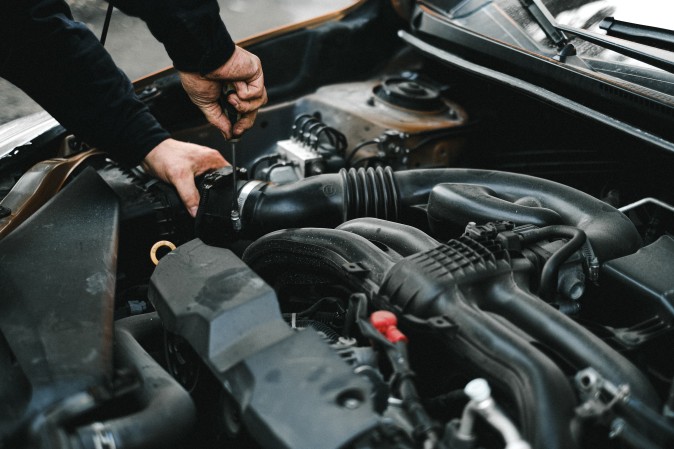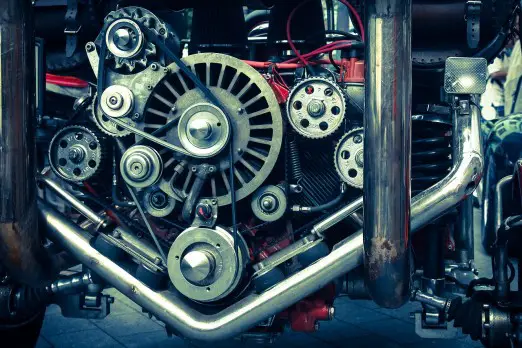When it comes to the complex world of car maintenance, choosing between 75W90 and 80W90 gear oils is crucial for owners of cars who want maximum durability and performance. These lubricants, the unsung heroes of the mechanical symphony of gears, are essential to the seamless functioning of many automobile systems. The key to comprehending the performance of these oils over a range of temperatures lies in the numerical designations, particularly the viscosity classes indicated by the letter ‘W’. To enable readers to make knowledgeable judgments based on the unique requirements of their cars and driving situations, this article aims to clarify the nuances between 75W90 and 80W90 gear oils.
Significance of Gear Oil in Automotive Systems:
Gear oil acts as a lifeline in the complex machinery of automotive systems, guaranteeing the smooth operation and durability of vital parts. Gears must withstand high pressure, heat, and friction to work well in transmissions, differentials, and other mechanical systems. Gear oil functions as a protective barrier, avoiding wear and tear by supplying necessary lubrication thanks to its unique composition. Beyond simple lubrication, gear oil is essential for heat dissipation because it lowers heat generated by friction, which can harm components. This increases the gears’ lifespan and improves the car’s overall efficiency. Gear oil, the silent defender of gear mechanisms that prevents premature wear and ensures the dependability and efficiency of automotive systems, is a prime example of the need for routine maintenance.

Understanding Viscosity Grades:
The viscosity of gear oil is a measure of the oil’s resistance to flow. The viscosity grade is represented by a combination of numbers and letters, such as 75W90 or 80W90. The Society of Automotive Engineers (SAE) has established a standardized system to classify viscosity grades, providing a universal language for consumers and manufacturers alike.
A. Explanation of SAE Viscosity Grades:
There are two components to the SAE viscosity grade. The first component, which is a number and a ‘W,’ indicates the viscosity of the oil during low or winter temperatures. The better the oil flows at lower temperatures, the lower this value is. The letter ‘W’ represents the word “winter.”
The viscosity of the oil at higher operating temperatures is indicated by the second component of the viscosity grade, which is denoted by a number without the letter “W.” Lower numbers indicate thinner oils, whereas higher values indicate heavier or more viscous oils.
B. Significance of the “W” in Viscosity Grade:
An essential indicator of the oil’s performance in colder climates is the ‘W’ in the viscosity grade. In the instance of 75W90, the ’75’ denotes the viscosity of the oil in the winter, demonstrating its capacity to flow at lower temperatures without obstructing the gear system’s operation.
It is critical to comprehend the effects of this “W” component, particularly for cars operating in climate-variable locations where temperature swings might be substantial.
C. Key Differences Between 75W90 and 80W90:
The main area where 75W90 and 80W90 vary from one another is in how well they operate in frigid temperatures. Although both are engineered to function well throughout a variety of temperatures, the numerical variation denotes unique properties that may impact the behavior of the oil in particular circumstances. The significance of these variations will be discussed in detail in this section, along with certain instances in which one viscosity grade may be preferable to another.
Temperature Considerations:
Temperature has a significant impact on gear oil performance; thus, car owners should select a viscosity grade that corresponds with the possible operating circumstances. The 75W90 vs. 80W90 discussion revolves around temperature considerations, which include both cold and high-temperature performance. These factors are critical to the effectiveness and safety of the vehicle’s gear.
A. Cold Temperature Performance:
Advantages and Disadvantages of 75W90:
- Advantages: Because of its reduced winter viscosity (W), 75W90 performs well in cold-start situations. Even in extremely chilly weather, gears will engage easily because of the thinner oil’s increased flow rate.
- Disadvantages: Because 75W90 is thinner than other oils, it may break down more quickly in hot climates, which might reduce its long-term efficacy.
B. High-Temperature Performance:
- Thermal Stability of 75W90:
- Advantages: In general, 75W90 has superior thermal stability at elevated temperatures. This quality is essential for maintaining performance under stressful circumstances, including extended highway driving or towing.
- Heat Resistance of 80W90:
- 80W90 offers strong heat resistance while having a heavier viscosity. This can be useful in situations when the gears are subjected to elevated temperatures, such as in off-road or heavy-duty applications.

Gear Protection and Lubrication:
Gear oil’s main purpose is to lubricate and safeguard the complex parts of a car’s gearbox system. When evaluating 75W90 and 80W90 gear oils, it is critical to evaluate how effectively they lubricate gears in different situations and how well they can protect against wear and friction.
A. Gear Wear and Friction:
- Role of 75W90 in Minimizing Wear:
- Advantages: Because 75W90 has a lower viscosity, it may reach and lubricate important parts more rapidly during cold starts. This characteristic helps to reduce gear wear, particularly during the first few minutes of operation when there is a greater chance of damage from friction.
- Considerations: Because 75W90 is thinner than other materials, it could be more difficult to provide the best possible protection against wear in harsh environments like elevated temperatures or heavy loads.
- Lubrication Properties of 80W90:
- Because it is a little thicker, 80W90 provides strong lubricating qualities, especially when the gearbox system is subjected to high loads or elevated temperatures.Advantages: Because 80W90 has a greater viscosity, it forms a longer-lasting lubricating coating that lowers friction and encourages smoother gear engagement.
- Considerations: 80W90 could take a little longer to attain the ideal viscosity for efficient lubrication during a cold start.
B. Extreme Pressure (EP) Additives:
- EP Additives in 75W90:
- Effective Extreme Pressure (EP) additives are a common feature of 75W90 compositions. By strengthening the oil’s resistance to high pressure, these additives give gears working with large loads or high torque an additional degree of protection.
- EP Additives in 80W90:
- EP additives are also frequently added to 80W90 gear oils, which strengthens their ability to withstand high-pressure situations. This is especially helpful in situations when gears are under a lot of stress, such as off-road driving or towing.
Application Specifics:
There is no one-size-fits-all decision when choosing between 75W90 and 80W90 gear oils since each viscosity grade has unique advantages and factors to consider that make them more appropriate for different applications. Making an informed choice requires knowing which gear oils work best with certain gear systems, following manufacturer recommendations, and being aware of how these oils operate differently in several types of transmissions.
A. Compatibility with Different Gear Systems:
- Manual Transmissions:
- 75W90: Ideal for manual gearboxes, particularly in colder regions where the thinner oil guarantees seamless gear changes right away.
- 80W90: gives manual transmissions strong protection and lubrication, especially in situations with high loads or temperatures.
- Automatic Transmissions:
- 75W90: The rapid flow characteristics of 75W90 may be advantageous for certain automatic gearboxes, guaranteeing timely lubrication during cold starts.
- 80W90: Provides stability in high-temperature situations, which makes it appropriate for some automatic gearboxes, particularly those that are used in harsh environments.

B. Manufacturer Recommendations:
- Vehicle-Specific Guidelines:
- When it comes to the viscosity grade of gear oil that works best with their gearbox systems, manufacturers frequently offer detailed suggestions. Following these recommendations is essential for both warranty compliance and optimal performance.
- Consideration of Climate:
- A certain viscosity grade may be advised by manufacturers depending on the environment of the area in which the vehicle is mostly used. By following these suggestions, you may be confident that the gear oil can tolerate the unique temperature problems the car encounters.
C. Performance in Manual and Automatic Transmissions:
- Manual Transmissions:
- 75W90: Perfect for cold environment manual gearboxes, it ensures smooth operation during cold starts and offers sufficient wear protection.
- 80W90: Ideal for manual gearboxes that are exposed to hot temperatures or heavy loads, since its thicker viscosity provides better protection.
- Automatic Transmissions:
- 75W90: Ideal for some automatic gearboxes, especially those that gain from oil that flows more quickly while the engine is cold.
- 80W90: stability in high-temperature situations, which makes it a good option for some automatic gearboxes, particularly under tough circumstances.
Environmental Considerations:
The environmental effect of automobile goods, notably gear oils, has gained substantial attention in an era of increased environmental consciousness. Making a sustainable decision when comparing the environmental effects of 75W90 vs 80W90 gear oils depends on several criteria, including biodegradability, recycling possibilities, and total environmental impact.
A. Environmental Impact of Different Gear Oils:
- Biodegradability:
- Certain gear oils may have greater biodegradability profiles than others, especially synthetic formulas. To minimize ecological effects, it is important to comprehend the destiny of gear oil in the environment after usage.
- Additive Packages:
- The environmental effect can be influenced by the makeup of additive packages, which include severe pressure additives and anti-wear compounds. Greener additives may be given priority in some formulations.
B. Recycling and Disposal Considerations:
- Recycling Programs:
- Some areas have a gear oil recycling program in place for spent motor oils. Car owners may dispose of old gear oil in an environmentally friendly manner by being aware of local recycling programs.
- Reuse Opportunities:
- Some gear oils, particularly those that satisfy premium requirements, may be reusable provided they have undergone the appropriate filtering and purification. This minimizes waste and lessens the requirement to produce new oil.
- Environmental Regulations:
- It is crucial to follow environmental standards when it comes to disposing of spent gear oil. Environmental standards are adhered to when local rules are comprehended and followed.
Frequently asked questions:
Can you use 80W90 in place of 75W90?
Because 80W90 has a higher viscosity at lower temperatures than 75W90, using it may influence performance in freezing weather conditions. Although 80W90 provides superior protection in hot weather, 75W90 is more appropriate for colder areas.
What is the function of 75W 90?
75W90 is used to lubricate gears, especially those in manual gearboxes and differentials. Its name denotes its capacity to remain stable at higher temperatures (90) and flow well in cold situations (75 for winter viscosity).
What is the purpose of 80W90 gear oil?
The main function of 80W90 gear oil is to preserve and lubricate gears, especially those found in differentials and manual gearboxes. The “80” denotes its viscosity in the winter, which guarantees proper flow during cold starts, while the “90” denotes its viscosity at warmer temperatures, which provides stability throughout a range of operating circumstances.
Is 80W90 thinner than 75W90?
In contrast to 75W90, 80W90 is thicker. A higher number denotes a thicker oil. The figures show the viscosity in the winter (cold).
Conclusion:
The choice between 75W90 and 80W90 gear oils captures a delicate balance between high-temperature robustness and cold-weather fluidity in the pursuit of optimal gear performance. Because it has less viscosity, the 75W90 version works well in colder regions. It minimizes wear and ensures quick lubrication during cold starts, which makes it perfect for manual gearboxes in severe winter weather. On the other hand, the thicker 80W90 equivalent provides strong protection and stability in hot conditions, making it appropriate for heavy-duty manual gearboxes or some automatic transmissions. The complexities of temperature considerations, gear protection, and application-specific requirements highlight the value of making an informed decision. Environmental consciousness adds another level of responsibility to this process, deciding sustainable automotive practices as much as performance.

